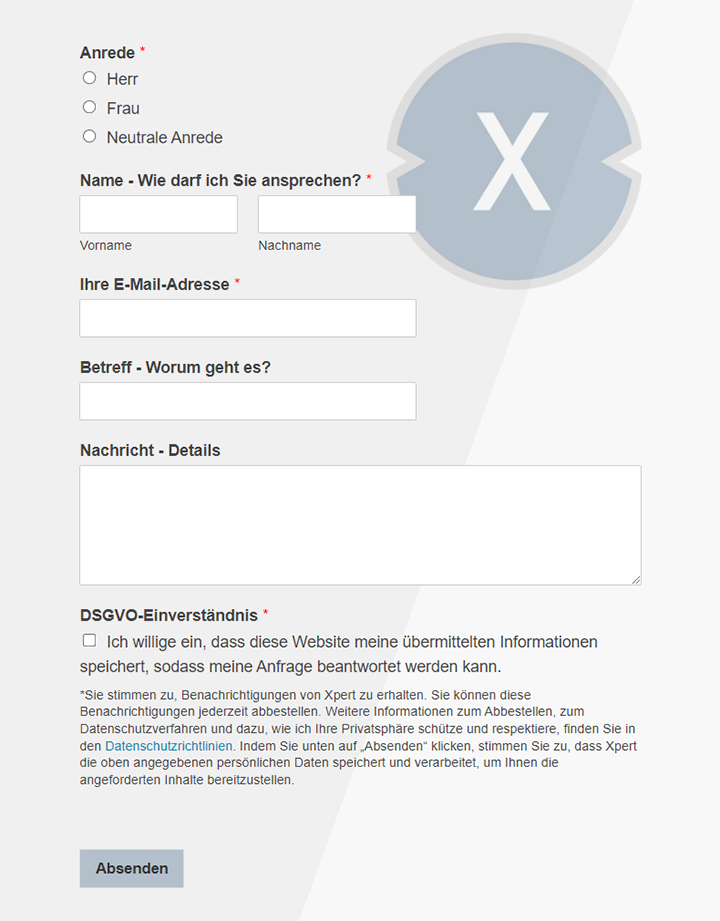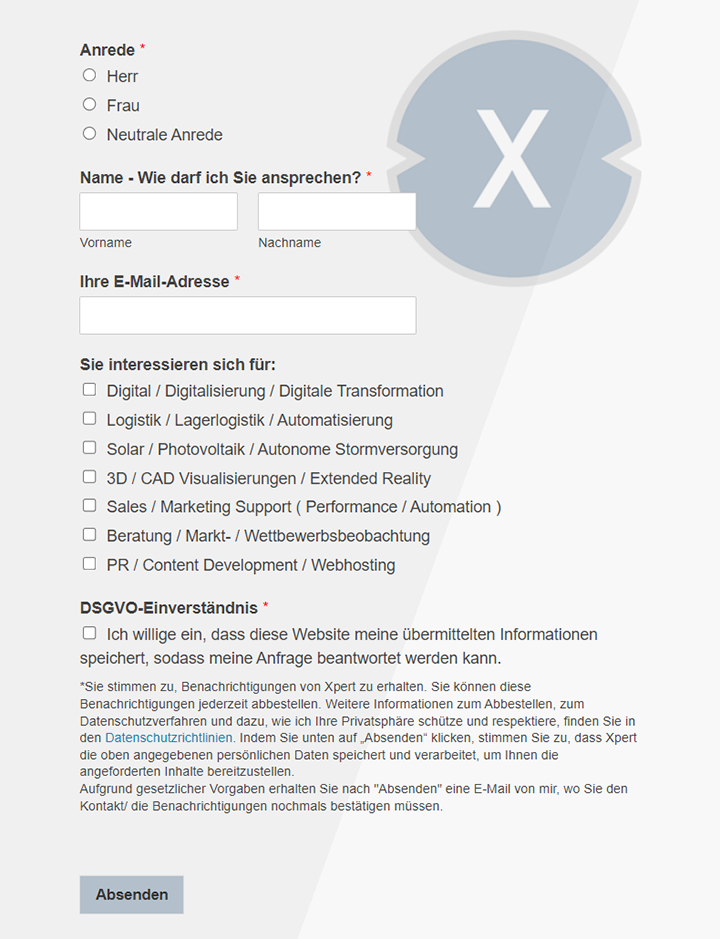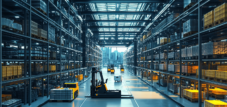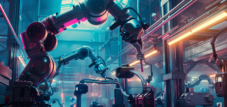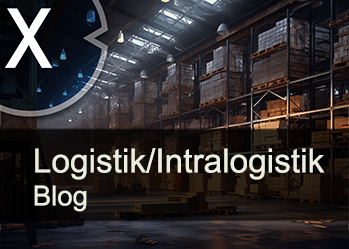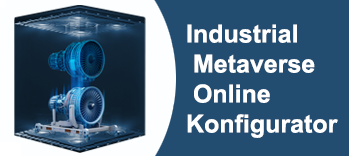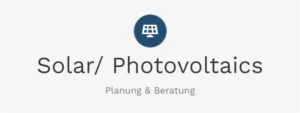Stacker Crane – The Silent Engine of Logistics: Why the Market for Stacker Cranes is Heading for $2 Billion
Xpert pre-release
Language selection 📢
Published on: August 28, 2025 / Updated on: August 28, 2025 – Author: Konrad Wolfenstein

Stacker Crane – The Silent Engine of Logistics: Why the Market for Stacker Cranes is Heading for $2 Billion – Image: Xpert.Digital
The global storage and retrieval equipment market: An in-depth analysis of technology, market dynamics, and competitive strategies
### E-commerce boom and skills shortage: How these megatrends are revolutionizing warehouse automation ### Intelligence instead of steel: How AI and supercapacitors are reinventing the modern high-bay warehouse ### The million-dollar decision in the warehouse: When is investing in a storage and retrieval machine really worthwhile ### Battle of the systems: Storage and retrieval machine vs. shuttle – which technology will win the race in the warehouse of the future? ###
German engineering at the forefront: Who dominates the global competition in warehouse automation
Behind the scenes of booming online commerce and global supply chains, a technological revolution is taking place, driven by unsung heroes: storage and retrieval machines (SRMs). These highly automated systems are the backbone of modern high-bay warehouses and the key to meeting the greatest challenges of our time. On the one hand, the unstoppable e-commerce trend is forcing companies to achieve maximum speed, utmost precision, and perfect space utilization. On the other hand, exploding warehouse space costs and an acute shortage of skilled workers are making manual processes increasingly uneconomical.
Amidst this dynamic landscape, the global market for storage and retrieval machines has developed into a dynamic, multi-billion-dollar industry. With an estimated volume of $1.15 billion by 2024 and a projected annual growth rate of over 7%, the industry is poised for a period of significant growth. However, competition is no longer decided solely by mechanical performance. The future belongs to intelligent, energy-efficient, and software-controlled systems. Innovations such as energy recovery using supercapacitors, AI-optimized driving strategies, and predictive maintenance are redefining performance and transforming the storage and retrieval machine into a smart hub in the digital warehouse.
This comprehensive analysis delves deep into the storage and retrieval machine market. It illuminates fundamental technologies, quantifies global and European market trends, and analyzes the strategic positioning of leading manufacturers such as SSI Schäfer, Jungheinrich, and Dematic. It also examines the key strategic question: How do companies navigate the high initial investments and the trade-off between the unmatched efficiency of storage and retrieval machines and the flexibility of alternative technologies such as shuttle systems to make the right, future-proof decision for the warehouse of tomorrow?
Suitable for:
- Top Ten ASRS Automated Storage and Retrieval System: Automated storage and retrieval system (RGB) manufacturers and companies
Billion-dollar intralogistics market: The silent technology boom
This article provides a comprehensive analysis of the global storage and retrieval machines (SRM) market and is intended for strategic decision-makers, investors, and product managers in the intralogistics industry. The analysis synthesizes technological specifications, market dynamics, the competitive landscape, and future trends to provide sound strategic insights.
The global market volume for storage and retrieval machines was estimated at approximately USD 1.15 billion by 2024 and is expected to grow at a consolidated annual growth rate (CAGR) of 6.5% to 7.5%, resulting in a projected market volume of over USD 1.65 billion by 2030. Europe is positioned as the fastest-growing region with a projected CAGR of 8%, driven by strong demand in Germany and the UK.
The primary growth drivers are irreversible macroeconomic trends. The unstoppable rise of e-commerce is putting enormous pressure on warehouses and distribution centers, which must ensure high storage density, maximum picking accuracy, and extremely fast order processing times. At the same time, rising costs for storage space and qualified personnel, as well as the general shortage of skilled workers, are forcing companies to invest in automation solutions that maximize space utilization and reduce dependence on manual labor. Storage and retrieval machines are a key technology for meeting these requirements through 24/7 operation, high precision, and the optimal use of vertical storage capacities of up to 46 meters in height.
Technologically, the market is driven by three key imperatives: energy efficiency, lightweight construction, and intelligent software integration. Leading manufacturers differentiate themselves through innovations such as energy recovery systems and the use of supercapacitors (supercapacitors) to mitigate peak loads, the use of lighter materials to reduce moving mass, and the integration of advanced control software that doubles mechanical efficiency through optimized driving strategies such as combined cycles.
The competitive landscape is dominated by global heavyweights such as Daifuku, SSI Schäfer, the Kion Group (with Dematic), and Murata Machinery, as well as strong European players such as Jungheinrich, Kardex Mlog, and Mecalux. These companies no longer compete solely on mechanical performance, but increasingly on the intelligence of their software, their integration expertise, and the ability to offer complete turnkey systems.
The greatest strategic challenge for potential users remains the high initial capital expenditure (CAPEX) and the complexity of system integration. These factors must be weighed against the long-term return on investment (ROI) achieved through significant savings in operating, personnel, and space costs. The decision to implement an AS/RS system also represents a strategic trade-off between the maximum efficiency offered by AS/RS in structured environments and the flexibility offered by alternative technologies such as shuttle systems. The future lies in hybrid, software-controlled systems that orchestrate the strengths of various technologies.
The storage and retrieval machine: Fundamental technology and system architecture
To fully understand market dynamics and the strategic positioning of competitors, a solid technological understanding of storage and retrieval machines is essential. This section analyzes the operating principles, core components, and systematic classification of this key technology in automated warehousing.
Functional principles and core components
A stacker crane (STC) or storage and retrieval machine (S/R machine) is a rail-guided, single-track vehicle designed for the automatic handling of goods in a high-bay warehouse. Its fundamental purpose is the storage, retrieval, and transfer of load units such as pallets, containers, or cartons.
The movement of the RBG occurs precisely in three orthogonal axes:
- X-axis: The longitudinal movement along the rack aisle on a floor-mounted track.
- Y-axis: The vertical lifting movement along the mast to reach the different shelf levels.
- Z-axis: The transverse movement of the load handling device to move the load unit into or out of the rack compartment.
The operational sequence of a typical work cycle is controlled by higher-level software. During storage, a conveyor system transports the unit load to the start of the aisle. The AS/RS travels to the transfer point, picks up the load, and moves in a simultaneous travel and lifting movement (X and Y axes) to the storage location assigned by the warehouse management system. There, the load handling device extends (Z axis) and deposits the pallet. A key efficiency feature is the so-called combined cycle or double cycle. In this case, after depositing a pallet, the AS/RS picks up another pallet for retrieval on the return journey. This software-controlled process halves the number of empty trips and practically doubles the machine's throughput compared to two separate individual cycles.
The mechanical structure of an RBG consists of several precisely coordinated main components:
Chassis (base): This box-shaped structure forms the base of the SRM. It contains the driven and non-driven wheels, which are guided on the floor rail and realize movement along the X-axis.
Mast (column): The mast is the main vertical axis of the SRM, made of high-strength steel. It connects the chassis to the upper guide and serves as a guide rail for the lifting carriage. It also often houses the main control cabinet and access points for maintenance work.
Lifting carriage (lifting platform): This component moves up and down along the mast (Y-axis) and carries the actual load-handling device. The lifting movement is typically achieved via a cable or chain drive powered by an electric motor.
Head beam (head section): Mounted at the top of the mast, the head beam contains guide rollers that run in an upper guide rail on the rack. It ensures the stability of the SRM, especially at great heights and high speeds, and dampens vibrations.
Load handling device (LHD): The LHD is the crucial interface to the load unit and significantly determines the flexibility and density of the storage system. The most common types include telescopic forks, which can hold one or two pallets in a row (single- or double-deep storage). For channel storage systems with very high storage density, a pallet shuttle is used as the LHD. This autonomous vehicle drives from the SRM into the rack channel to deposit or pick up pallets. For flow racks, integrated roller or chain conveyors are used to transfer the pallet to the racking system.
A taxonomy of storage and retrieval machine systems
The market for storage and retrieval machines is heterogeneous, offering a wide variety of systems tailored to specific requirements. A systematic classification helps structure this diversity.
According to mast construction
Single-mast stacker cranes: Consist of a single vertical column. They are generally lighter and more cost-effective, making them an attractive option for applications with lower to medium loads and heights. They are ideal for companies seeking an efficient automation solution with an optimized cost-benefit ratio.
Twin-mast stacker cranes: These feature a frame construction with two masts, between which the lifting carriage is guided. This design offers greater stability, rigidity, and load capacity. They are the preferred choice for high-bay warehouses with great heights (up to 46 m), heavy loads (over 1,500 kg), and high speed and throughput requirements.
By loading unit
Pallet-loading (unit-load) stacker cranes: These machines are designed for handling standardized large load carriers such as Euro pallets or industrial pallets. They form the backbone of automated logistics in distribution centers and production warehouses and can move loads typically ranging from 1,000 kg to over 10,000 kg for specialized applications.
Miniload (small parts) AS/RS: These smaller and lighter AS/RS are optimized for the rapid handling of small parts in bins, cartons, or on trays. They are the heart of automated small parts warehouses (AS/RS) and are used for production supply or e-commerce order picking.
After lane binding
Aisle-based stacker cranes: This is the most common and efficient configuration, with each stacker crane operating permanently in a single racking aisle. This enables maximum throughput, as all aisles can be served in parallel.
Curved AS/RS/Aisle Change Systems: These machines can change aisles, reducing the number of AS/RS required and thus lowering the initial investment. Aisle change occurs either via a transfer bridge that moves the entire AS/RS across the aisles, or via curved switches in the rail system. However, this flexibility comes at the expense of overall performance, as aisle change takes time and a single machine must serve multiple aisles.
Specialized designs
Three-way stacker cranes: These machines have a rotating head that can pick up pallets from the front as well as from the left and right. They are a niche solution that is particularly suitable for the gradual automation of existing manual narrow-aisle warehouses, as they operate similarly to three-way stackers and often do not require an upper guide rail.
Deep-freeze applications: Many AS/RS models are designed for continuous use in deep-freeze warehouses at temperatures as low as -30°C. This requires special materials, lubricants, and encapsulated electronics to ensure reliability under extreme conditions.
The role of software and control
The mechanical performance of a storage and retrieval machine is only one side of the coin. Its actual efficiency in warehouse operations is largely determined by the intelligence and integration of its software and control systems. An AS/RS is therefore not just a machine, but an integrated mechatronic and cybernetic system. Its performance results from the symbiosis of powerful hardware and intelligent software. While the mechanical components define the physical potential, it is the software that accesses, coordinates, and optimizes this potential. Purely software-controlled optimizations such as the combined cycle can double efficiency without changing the hardware. Likewise, intelligent storage location allocation by the higher-level system minimizes the AS/RS travel routes, thereby increasing the throughput of the entire warehouse. The true performance of an AS/RS system therefore only emerges from seamless interaction within the entire software hierarchy.
The control architecture is typically hierarchical:
Warehouse management system (WMS): At the highest level, the WMS manages the entire warehouse inventory, plans the storage and retrieval strategies (e.g. ABC analysis, FIFO) and generates the transport orders.
Material Flow Controller (MFC) / Warehouse Control System (WCS): This intermediate layer receives orders from the WMS and translates them into specific, optimized movement commands for the lower-level control levels. The MFC coordinates the movements of the SRM with the connected conveyor technology to ensure smooth and efficient material flow.
Programmable Logic Controller (PLC): The PLC is the "brain" of the stacker crane. It receives travel commands from the MFC and controls the individual motors for travel, lifting, and traverse movements. It monitors all sensors and safety devices on the device.
Communication between the central control system and the moving SRM is carried out via various technologies, including conductor rails, contactless data light barriers (infrared) or, increasingly, via robust industrial WLAN (IWLAN), which enables flexible and low-maintenance data transmission.
The systems offer various operating modes: Fully automatic operation is the standard, in which the AS/RS autonomously processes the orders transmitted by the MFC. For maintenance, setup, or troubleshooting purposes, there are semi-automatic modes (e.g., moving to a specific compartment at the push of a button) and purely manual operation via an emergency control station, which is usually mounted directly on the device.
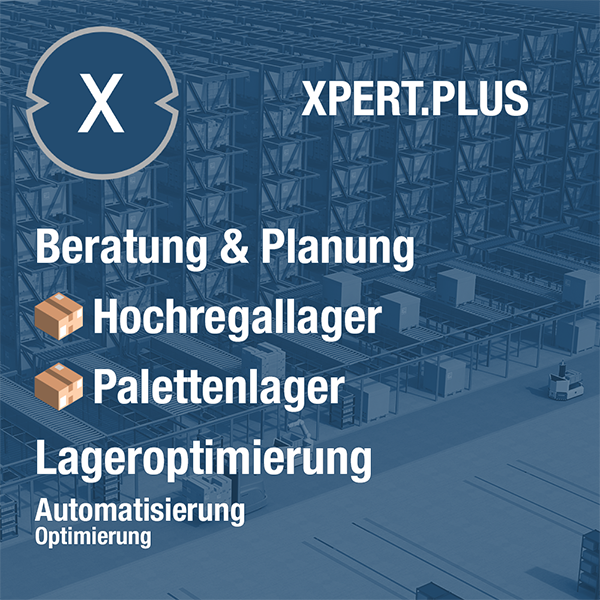
Xpert.Plus warehouse optimization - high-bay warehouses such as pallet warehouses consulting and planning
Digital Transformation: Why Companies Are Investing in Warehouse Automation Now
Global and European market analysis and forecast
Quantifying the storage and retrieval equipment market and identifying regional and segment-specific growth trends are crucial for formulating business strategies. This section provides a data-driven analysis of the global and European market based on the consolidation of recent market research reports.
Suitable for:
- Market analysis and technology leader: A comprehensive Q&A guide to the top manufacturers of high-bay warehouse
Global market volume and growth forecast
The global storage and retrieval machine market is experiencing robust and steady growth. Estimates for the market volume in the early 2020s vary depending on the source but remain within a consistent range. The market was valued at approximately USD 977 million in 2021, while other analyses indicate a value of USD 1.1 billion for 2022. More recent estimates place the market at USD 1.09 billion in 2023 and forecast a volume of USD 1.15 billion for 2024.
Forecasts for the future growth rate (CAGR) vary considerably due to different methodologies and time frames. Forecasts range from 6.2% to 6.6% to 6.7%, up to the more ambitious 12.2%. A consolidated and realistic assessment suggests a compound annual growth rate in the range of 6.5% to 7.5%. Based on this corridor, the global market is expected to grow from approximately USD 1.15 billion in 2024 to over USD 1.65 billion by 2030 and potentially to over USD 2 billion by 2032. This growth will be largely driven by advancing automation in logistics and rising demand from the e-commerce sector.
Europe as a growth center
While the Asia-Pacific region, led by China and India, currently holds the largest market share, Europe is forecast to be the fastest-growing region for storage and retrieval systems. In 2024, Europe accounted for approximately 17.7% of global market revenue, equivalent to a volume of USD 204.1 million.
Forecasts for the European market are extremely positive. A CAGR of 8.0% is expected for the period from 2025 to 2030, which will increase the market volume to USD 321.5 million by 2030. This above-average growth will be driven by massive investments in smart manufacturing, the increasing automation of supply chains, and the high density of industrial and logistics companies in the region. Within Europe, Germany, the traditional heart of intralogistics with numerous manufacturers and system integrators, and the United Kingdom, which is expected to have the highest CAGR, are considered the driving country markets.
Analysis of market segmentation
A detailed analysis of the market segments reveals the specific drivers and dynamics within the overall market.
By type
The single-mast stacker crane segment dominated the market in 2023, accounting for over 49% of revenue. Their cost-effectiveness, smaller footprint, and versatility make them the preferred choice for small and medium-sized enterprises (SMEs) looking to enter automation. In contrast, the dual-mast stacker crane segment is forecast to experience the fastest growth. Their superior stability, higher load capacity, and high performance are essential for the demands of large, highly dynamic distribution centers and production warehouses.
By degree of automation
Fully automated systems represent the largest and fastest-growing segment. The primary incentive for implementing AS/RS is to maximize efficiency and reduce human intervention, making fully automated systems the logical choice. They operate autonomously based on orders transmitted by the WMS/MFC and enable 24/7 operation.
Semi-automatic systems that enable a combination of automated cycles and manual interventions retain their relevance in niche markets, particularly when retrofitting existing systems or in processes that require close interaction with picking personnel.
By end-user industry
The consumer goods industry has traditionally been the largest user of AS/RS systems to efficiently store and distribute the high volumes and variety of products. However, the strongest growth is expected in the e-commerce/retail and automotive sectors. E-commerce requires extremely fast and error-free order processing, which is driving the use of automated small parts warehouses (AS/RS) with miniload AS/RS. In the automotive industry, complex production methods such as just-in-time and just-in-sequence supply are driving demand for highly available and precise AS/RS systems for buffering and staging components and car bodies. Other important user industries include the pharmaceutical industry, which benefits from precise and safe handling in controlled environments, and the food and beverage industry, particularly in frozen food applications.
Global Stacker Cranes Market – Forecast by Region (2024–2032, in USD Million)

Global Storage and Retrieval Equipment Market – Forecast by Region (2024–2032, in Million USD) – Image: Xpert.Digital
Note: The values are consolidated estimates based on the sources.
The global market for storage and retrieval machines is poised for impressive growth in the coming years. Steady growth is expected across all regions of the world from 2024 to 2032, with the total market projected to grow from USD 1.15 billion to USD 2.03 billion. This represents a compound annual growth rate of approximately 7.4%.
The Asia-Pacific region is leading this development with a projected market volume of USD 920 million. This growth is driven by the strong development of the manufacturing sector in China and India, as well as increasing e-commerce penetration and the modernization of logistics infrastructure. With a growth rate of 7.6%, the region demonstrates enormous potential.
Europe follows with a forecast of USD 385 million and a growth rate of 8.0%. Factors such as high levels of automation, Industry 4.0 initiatives, and a strong e-commerce market will play a decisive role here. North America is expected to reach USD 580 million, driven by high labor costs, skilled labor shortages, and the need to modernize existing facilities.
Latin America and the Middle East & Africa also show growth potential, with forecasts of USD 75 million and USD 70 million, respectively. Industrialization, investments in logistics hubs, and the growing retail sector are key drivers in these regions.
Overall, the global storage and retrieval machine market is driven by the e-commerce boom, rising warehousing and labor costs, and the drive for efficiency and resilience in the supply chain.
European Storage and Retrieval Machines Market – Forecast by End-User Industry (2024–2030, in USD million)

European Storage and Retrieval Machines Market – Forecast by End-User Industry (2024–2030, in USD million) – Image: Xpert.Digital
Note: The values are derived estimates based on the sources.
The European market for storage and retrieval machines shows promising development in the coming years. The forecast for the period from 2024 to 2030 highlights steady growth across various end-user industries.
The e-commerce/retail and automotive segments are developing particularly dynamically, with projected growth rates of 9.2% and 9.8%, respectively. The total market is expected to grow from USD 204.1 million in 2024 to USD 321.5 million in 2030, corresponding to a compound annual growth rate (CAGR) of approximately 8%.
Every industry uses storage and retrieval machines for specific applications: consumer goods uses them for high-density storage, e-commerce for automated small parts warehouses, the automotive industry for just-in-time logistics, and the pharmaceutical industry for temperature-controlled and traceable storage.
The drivers of this growth are automation, efficiency improvements and technological innovations that help companies optimize their warehouse processes and remain competitive.
Key market drivers and strategic challenges
The storage and retrieval equipment market is shaped by several powerful, mutually reinforcing forces. A deep understanding of these drivers and the associated challenges is crucial for assessing current and future market developments and defining strategic positions.
Primary growth catalysts
Three fundamental macro trends act as primary catalysts for the increasing demand for RBG systems.
The unstoppable rise of e-commerce
The exponential growth of online commerce has fundamentally changed the demands on logistics. Customer expectations for extremely short delivery times ("same-day delivery") and high service quality are placing enormous pressure on distribution centers to be more efficient. E-commerce is characterized by a "chaotic flow of goods": a high number of small, customized orders, a wide variety of stock units (SKUs), and high return rates. Manual processes can no longer handle this complexity and speed. Automated warehouse systems, especially miniload warehouses with fast miniload storage and retrieval systems, are a key technology for minimizing pick & pack times, ensuring high picking accuracy, and maximizing storage density for a wide range of items. E-commerce is therefore a direct driver for investments in warehouse automation.
Economic pressure due to rising costs
The economic viability of automation solutions is increasingly positively influenced by two cost factors: space and personnel costs. Prices for logistics real estate, especially in strategically advantageous locations near urban centers, are continuously rising. At the same time, the shortage of qualified workers in logistics is leading to rising wages and difficulties in staffing. Stacker crane systems address both problems directly. By utilizing the full building height (up to 46 meters) in very narrow aisles (approximately 1.5 meters), they maximize storage density and significantly reduce the required footprint. At the same time, they reduce the dependence on manual personnel for strenuous and repetitive storage and retrieval processes, which not only reduces costs but also increases occupational safety.
The pursuit of efficiency and resilience in the supply chain
Beyond cost savings, AS/RS systems offer fundamental operational advantages. They enable uninterrupted 24/7 operation, maximizing throughput and asset utilization. Computer-controlled precision minimizes errors during storage and retrieval, resulting in greater inventory accuracy and better service quality for the end customer. This high level of reliability and transparency creates more robust and resilient supply chains that are less susceptible to disruptions caused by human error. In a globalized economy where supply chain disruptions pose a significant risk, this predictability and reliability become a decisive competitive advantage.
Investment barriers and operational obstacles
Despite the compelling advantages, there are significant hurdles to the widespread adoption of RBG systems that require careful strategic consideration.
High initial investments (CAPEX)
The biggest barrier is the significant initial investment. The costs of an automated warehouse system include not only the storage and retrieval machines themselves, but also the high-precision rack and steel construction, the upstream and downstream conveyor technology, the electrical system, and, above all, the complex software for control and management. These high total costs represent a significant financial hurdle, especially for small and medium-sized enterprises (SMEs), and require a detailed and often long-term amortization calculation.
Complexity and integration effort
Implementing an AS/RS system is not a plug-and-play process. It is a complex, large-scale project that requires extensive interventions in a company's existing infrastructure and IT landscape. Seamless integration with higher-level systems such as Enterprise Resource Planning (ERP) and the Warehouse Management System (WMS) is critical to success and can be complex. Furthermore, companies often become tightly tied to a single system supplier, which can lead to a technological lock-in that complicates future changes or expansions.
Competition from alternative technologies and the “efficiency-flexibility trade-off”
The warehouse automation market is characterized by a fundamental conflict between maximum efficiency and maximum flexibility. Storage and retrieval machines are the undisputed champions of efficiency in static, high-volume environments. Their strength lies in maximum space utilization and high throughput in clearly defined aisles. However, they reach their limits when high flexibility and scalability are required. This is where alternative technologies such as shuttle systems come to the fore. In these systems, horizontal and vertical movements are decoupled, enabling higher throughput rates. Performance can be flexibly scaled by adding additional shuttles, and redundancy is higher because the failure of one shuttle does not paralyze the entire system. Autonomous mobile robots (AMRs) offer the greatest flexibility because they are not rail-bound, but sacrifice the vertical storage density provided by an AS/RS. The strategic decision for or against an AS/RS is therefore not a question of "better" or "worse," but a conscious consideration of this "efficiency-flexibility trade-off." For a high-bay warehouse with stable processes and the goal of maximum storage density, an AS/RS remains the optimal solution. For a dynamic e-commerce warehouse with highly fluctuating order profiles, a shuttle system might be superior.
Strategic Recommendation: Navigating the Investment Paradox
The decision to invest in an AS/RS requires a holistic approach that goes beyond the acquisition costs alone. A robust business case framework must evaluate the return on investment (ROI) over the entire life cycle of the system. The payback period typically ranges from three to five years, but can be shortened to two to three years with a high degree of automation and strong company growth.
The calculation must quantify the following factors:
- Reduced operating costs (OPEX): Direct savings in personnel costs (wages, social security contributions, recruitment) and lower costs due to errors (mispicking, returns, inventory discrepancies).
- Optimized space utilization: Quantify the avoided space requirement compared to a manual warehouse, resulting in lower rental or construction costs.
- Increased throughput and revenue: Evaluate the additional capacity and faster order processing, which can lead to higher revenue and better customer satisfaction.
- Intangible benefits: Consideration of benefits that are harder to quantify, such as increased occupational safety, better process control, and increased supply chain resilience.
Companies must carefully analyze their specific requirements to select the right technology within the efficiency-flexibility spectrum. A detailed material flow and process analysis is the first and most important step to avoid a bad investment.
🔄📈 B2B trading platforms support – strategic planning and support for exports and the global economy with Xpert.Digital 💡
Business-to-business (B2B) trading platforms have become a critical part of global trade dynamics and thus a driving force for exports and global economic development. These platforms offer significant benefits to companies of all sizes, particularly SMEs – small and medium-sized businesses – which are often considered the backbone of the German economy. In a world where digital technologies are becoming increasingly prominent, the ability to adapt and integrate is crucial to success in global competition.
More about it here:
High-tech in the warehouse: The most exciting innovations in the industry
Competitive landscape and manufacturer in-depth analyses
The global market for storage and retrieval machines is characterized by a group of established, technologically leading companies. While the market is considered concentrated, competition is intense, primarily driven by technological innovation, system integration expertise, and global presence. This section analyzes the key players and their strategic positioning.
Suitable for:
- Top Ten Miniload: The Mini-Load AS/RS storage and retrieval system, also for small parts warehouses of manufacturers and companies
Market shares and competitive positioning
The top of the global market is dominated by a handful of large international corporations. These include, in particular, the Japanese company Daifuku Co., Ltd., often cited as the global market leader in material handling; the German SSI Schäfer Group; the Kion Group AG (which includes the systems integrator Dematic); Murata Machinery, Ltd. (Japan); and Swisslog AG (part of Kuka AG). These companies offer a comprehensive portfolio ranging from components to complete turnkey systems and possess strong global sales and service networks.
In Europe, and especially in German-speaking countries, this field is complemented by other highly specialized and innovative companies. Jungheinrich AG, Kardex (with its German subsidiary Kardex Mlog), and the Spanish company Mecalux SA are significant competitors, playing a significant role in both the European and global markets. Competition is increasingly focused on providing complete solutions, where the seamless integration of hardware (AS/RS, conveyor technology) and software (WMS, WCS) represents the decisive added value for the customer.
Profiles of leading European manufacturers (Focus Germany)
German mechanical and plant engineering has traditionally played a leading role in intralogistics. Manufacturers based here are considered technology leaders and set standards in terms of performance, quality, and innovation.
SSI Shepherd
As one of the world's leading providers of logistics systems, SSI Schäfer offers a highly flexible and efficient family of storage and retrieval machines with the SSI Exyz series. A key feature is the modular design principle. The components are mass-produced and can be configured as single- or double-mast machines for various loads and heights, depending on customer requirements. This enables a high degree of flexibility combined with short delivery and commissioning times. A strong focus is placed on energy efficiency under the "Green Crane Technology" label. This includes, as standard, the regeneration of braking energy into the grid, intelligent DC coupling of the drive controllers, and demand-based adaptation of travel profiles. With the new, more compact SSI Exyz C module, the company is specifically targeting the market for the automation of existing warehouses with lower heights (up to 13.5 m) without the need for complex floor renovations.
Jungheinrich AG
Jungheinrich has positioned itself as a technology leader in the field of automated small parts warehouses with its self-developed STC 2B1A miniload stacker crane. The unit sets standards in two key areas: performance and energy efficiency. With travel speeds of over 6 m/s and accelerations of more than 5.3 m/s², it is one of the most powerful units in its class. Its unique technological feature is the use of "supercapacitors" as energy storage units. These store the energy released during braking and release it during the next acceleration. This eliminates expensive peak loads in the power grid, reduces the required connected load by up to 25%, and significantly lowers energy costs. Thanks to an innovative design with an Omega drive integrated into the mast base, the STC also achieves the smallest approach dimensions in its class, enabling maximum utilization of the available storage volume.
Dematic (Kion Group)
Dematic, part of the Kion Group, offers a wide range of storage and retrieval machines for pallets (unit load, UL) and small parts (miniload, ML) with the RapidStore family. Dematic's strength lies in providing highly configurable and scalable systems tailored to specific throughput and height requirements (up to 46 m). The miniload machines are known for their high dynamic performance, with travel speeds of up to 6 m/s and accelerations of up to 5.5 m/s². Dematic places a strong focus on its role as a general contractor and systems integrator, seamlessly embedding the SRMs into an overall system comprising conveyor technology and the proprietary Dematic iQ software suite (WMS/WCS) to ensure optimized and transparent material flow.
Kardex Mlog
Kardex Mlog looks back on a long history, dating back to the development of one of the first floor-guided stacker cranes in 1968. This experience is reflected in its specialization in robust and customized high-bay warehouses for pallets reaching heights of up to 46 m. Kardex Mlog differentiates itself through innovative load handling devices. The patented Kardex MSpacer, a special telescopic fork, enables more space-saving double-deep storage, thus significantly increasing storage space per aisle. With the Kardex MMove, the company also offers its own pallet shuttle for multi-deep storage. Another strategic focus of Kardex Mlog is retrofitting, i.e., the modernization and performance enhancement of existing systems, including those from third-party manufacturers, which serves an important and growing niche in the market.
Profiles of leading global competitors
Daifuku Co., Ltd.: As a global market leader in the entire material handling sector, Daifuku offers an extremely broad and deep portfolio of AS/RS solutions. Applications range from production logistics (e.g., buffer storage for the automotive industry, tool storage) to large distribution centers for retail, e-commerce, and the food industry. Daifuku's strength lies in its global presence and its ability to implement highly complex and large-scale automation projects as a general contractor.
Suitable for:
- Japanese world market leader develops state-of-the-art AS/RS system for commercial vehicle manufacturers
Mecalux, SA: The Spanish company Mecalux has positioned itself as a strong provider of complete, turnkey warehouse solutions. Its product portfolio of AS/RS is broad and includes various models (e.g., the SCX series for high performance, the MT0 series for retrofitting) for different heights, loads, and throughput requirements. Mecalux not only manufactures the AS/RS but also the racking systems and develops its own warehouse management software, Easy WMS, enabling a high level of system integration from a single source.
Technological comparison of leading RBG models (examples)
Note: These specifications are approximate and may vary depending on the configuration. Data was extracted and consolidated from the specified sources.
In the world of warehouse technology, there are numerous innovative storage and retrieval machine (SRM) solutions, each distinguished by its own technological features and performance parameters. Leading manufacturers such as SSI Schäfer, Jungheinrich, Dematic, Kardex Mlog, and Mecalux develop state-of-the-art systems tailored to specific logistics requirements.
SSI Schäfer, for example, presents the SSI Exyz model, featuring a modular design and remarkable Green Crane Technology that regenerates energy. Jungheinrich relies on supercapacitors for energy storage with the STC 2B1A, achieving outstanding acceleration. Dematic impresses with its RapidStore ML, offering high dynamics and flexible load handling devices, while Kardex Mlog specializes in customized high-bay warehouses.
Mecalux completes this overview with its SCX series, which offers a comprehensive solution comprising an AS/RS, racking, and warehouse management system. The models differ in parameters such as maximum height, travel speed, and load capacity, but all demonstrate a commitment to optimizing and automating warehouse processes.
Technological evolution and future outlook
The stacker crane, a technology with a history spanning over 60 years, is on the cusp of a new evolutionary stage. Driven by economic constraints and technological opportunities, the development focus is shifting toward greater efficiency, intelligence, and networked systems. This section analyzes the defining technology trends and outlines the future role of the stacker crane in the warehouse of the future.
The imperative of efficiency: energy and material
Given rising energy costs and a growing awareness of sustainability, energy efficiency has become a key development goal and an important purchasing criterion. Manufacturers are pursuing two main strategies:
Energy management and recovery
Modern SRMs are equipped with intelligent energy management systems. A key technology is recuperation, which converts the kinetic and potential energy released when the travel axis decelerates or the lifting carriage lowers into electrical power. This energy can either be made available directly to other drives via a DC link or fed back into the power grid. Systems that use energy storage devices such as supercapacitors (supercapacitors) go a step further. These buffers store the braking energy and make it available again for the next acceleration phase, which requires the most power. This drastically reduces expensive peak loads in the grid, lowers the required connected load, and can reduce overall energy consumption by up to a third.
Lightweight construction
The second lever for increasing efficiency is reducing the moving mass. Every kilogram that doesn't need to be accelerated and decelerated saves energy and enables greater dynamics. Manufacturers are therefore increasingly turning to lightweight construction by using optimized steel structures, aluminum (especially for miniload masts), or even, in pilot projects, fiber composite materials such as carbon fiber reinforced plastic (CFRP). A lighter construction not only reduces energy consumption but also wear on drive and guidance components, which lowers maintenance costs and increases service life. Radical research approaches even aim to completely replace the heavy mast with a cable robot-based guidance system, which promises a weight reduction of up to 90%.
The rise of intelligent systems: AI, IoT and predictive maintenance
The next stage of the AS/RS evolution will be ignited by the integration of sensors, data processing, and artificial intelligence (AI). The AS/RS will transform from a pure execution machine into an intelligent, data-generating hub in the logistics network.
Intelligent control and sensor technology
Advanced algorithms and AI can optimize driving strategies in real time. Instead of rigid motion profiles, the systems can learn to dynamically optimize the paths between storage and retrieval points to maximize throughput. High-resolution sensors, such as vision sensors or laser scanners, improve the precision of fine shelf positioning, detect obstacles or faulty pallets, and thus increase process reliability.
Condition monitoring and predictive maintenance
By equipping the SRM with a variety of sensors (for vibration, temperature, power consumption, etc.) and connecting them via the Internet of Things (IoT), continuous condition monitoring becomes possible. The collected data can be analyzed to detect anomalies and predict maintenance needs (predictive maintenance) before an actual failure occurs. This significantly increases plant uptime and converts unplanned downtime into planned maintenance interventions.
The future of high-bay automation
The stacker crane will continue to play a central role in automated warehouse logistics, especially where maximum storage density is required within a limited footprint. However, it will rarely be viewed as an isolated, stand-alone solution. The future lies in hybrid and orchestrated systems. A warehouse of the future could look like this:
- A core of high-density shelving, served by energy-efficient, intelligent storage and retrieval machines, serves as the backbone for mass storage.
- Connected, highly dynamic shuttle systems that act as buffers and sequencers for picking.
- A fleet of Autonomous Mobile Robots (AMRs) that flexibly transport goods between the high-bay warehouse, the shuttle buffers, the picking stations, and the goods issue area.
The key to the success of such heterogeneous systems is software. A higher-level Warehouse Execution System (WES), enhanced with AI, will orchestrate these various technologies in real time to optimize the material flow as a whole and dynamically adapt to changing order situations.
Strategic recommendation: Future-proof automation investments
For companies investing in automation today, these trends provide clear strategic recommendations. The selection should be based not only on current performance data, but above all on future viability. Investors and operators should focus on modular, scalable, and open-software systems. The ability to easily expand a plant in the future or integrate new technologies (e.g., new LAM types, AMRs) is crucial for long-term investment protection.
Selecting the right partner is more important than ever. A provider's expertise in software, systems integration, and service is becoming more important than a device's mere mechanical specifications.
This development indicates a fundamental shift in manufacturers' business models. The increasing complexity of software, the need for continuous AI-based optimization, and customers' focus on maximum availability are laying the foundation for a transition from pure hardware sales (CAPEX model) to service-oriented approaches. Customers no longer simply purchase a crane, but rather guaranteed throughput and availability. This could lead to business models such as "Asset as a Service" or "Performance as a Service," in which the high initial investment is converted into predictable operating costs (OPEX) for the customer. For manufacturers, this shift from product to solution and service provider represents one of the most important strategic transformations of the coming years.
We are there for you - advice - planning - implementation - project management
☑️ SME support in strategy, consulting, planning and implementation
☑️ Creation or realignment of the digital strategy and digitalization
☑️ Expansion and optimization of international sales processes
☑️ Global & Digital B2B trading platforms
☑️ Pioneer Business Development
I would be happy to serve as your personal advisor.
You can contact me by filling out the contact form below or simply call me on +49 89 89 674 804 (Munich) .
I'm looking forward to our joint project.
Xpert.Digital - Konrad Wolfenstein
Xpert.Digital is a hub for industry with a focus on digitalization, mechanical engineering, logistics/intralogistics and photovoltaics.
With our 360° business development solution, we support well-known companies from new business to after sales.
Market intelligence, smarketing, marketing automation, content development, PR, mail campaigns, personalized social media and lead nurturing are part of our digital tools.
You can find out more at: www.xpert.digital - www.xpert.solar - www.xpert.plus










